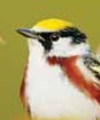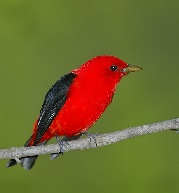Land
Preserved Land Forests
Farmland To Get Back On Track
Forests

Most Recent Available Data
Forest Birds

The number of birds nesting in Connecticut's forests has been shrinking. This is true for birds that nest in mature forests as well as for birds that nest in young forests and "shrublands." The 2017 nesting season (most recent data) brought a slight improvement for most forest-bird species, though some declined.

Birds that nest in Connecticut's forests have been declining in number for a decade, which could reflect changes in the health of the forest ecosystems.
_______________
Top chart (Forest Acres): Forests that are at least 300 feet from non-forest development -- roads, buildings and farms -- are classified as core forests. Core forests provide habitat for many species of wildlife that cannot tolerate significant disturbance. Forests that are fragmented, or divided by roads and clearings, provide some forest functions but are not fully-functioning forest ecosystems. Fragmented forests are known to provide substandard or poor habitat for some species of wildlife and, in many cases, less opportunity for hunting and other types of recreation. Invasive species of plants and animals appear in the wake of activities that fragment the forests.
The acreage of forests can fluctuate over years or decades, increasing as fields grow into forests and declining as timber is harvested by clear-cutting or as agricultural fields are expanded. These temporary fluctuations are distinct from permanent declines caused by road and building construction.
The economic recession that began in 2008 slowed (but did not halt) new construction in most parts of the state. During the lull in land development, some areas that were observed to be cleared land in 2010 became forests by 2015. Gains appear to have balanced the losses. This five-year period of unchanging forest acreage is highly unusual in Connecticut's modern history.
Birds as Indicators of Forest Health
The Connecticut Forestlands Council Forest Ecosystem Health Committee* developed a list of Avian Forest Health Indicator Species that "can be used as indicators in identifying both positive and negative areas of forest ecosystem health." From that list, the Council on Environmental Quality selected two groups of species that best typify forest birdlife throughout the state.** In selecting the species, the Council was aided invaluably by five experts in ornithology.***
The Council calculates index values (using advice from statistics experts) to show the combined population trends of several woodland species. In the bottom chart, the red dots follow the combined nesting populations of eight species of birds that typically inhabit mature forests in Connecticut:
Hairy Woodpecker Wood Thrush
Eastern Wood-Pewee Red-eyed Vireo
Scarlet Tanager Black-and-white Warbler
Veery Ovenbird
The yellow dots track the nesting populations of five bird species that typically inhabit forests that are young or dominated by shrubby vegetation, sometimes known as "shrublands":
American Redstart
Blue-winged Warbler
Chestnut-sided Warbler
Eastern Towhee
Yellow Warbler
Both categories of forest birds have been declining faster than the forests themselves. This rapid decline could be caused by several factors. Most of the mature-forest bird species are affected greatly by fragmentation. Predators, invasive species, overpopulating deer and human activities follow roads and other intrusions into the forests and cause nesting success to falter. The true forest birds, those that are not adapted to disturbed roadside or suburban habitat, will succeed in the long term only in forests that are not fragmented. After years of decline in the acreage of core forest, one would expect to see declines in many bird species, and Connecticut is seeing such a decline. Many studies have identified a time lag period between the fragmentation of a forest and the decline in birds, explained probably by the fact that the birds' breeding success diminishes gradually, not instantaneously, when a forest is divided into smaller parcels. The link between the conservation of unbroken forests and bird populations is the subject of the Connecticut Audubon Society's 2015 State of the Birds report.
Songbirds that depend on young forests have seen their habitat lost to development and to aging of the trees. Other young-forest wildlife, such as the New England Cottontail and Ruffed Grouse, also have declined as such habitat has dwindled. Many landowners, including the state, have taken action to expand this type of forest habitat. Where land is managed to encourage young forests and shrublands, the wildlife responds favorably, but such managed areas are small in total. In late 2016, the federal government approved the creation of the Great Thicket National Wildlife Refuge across six states that could protect habitat for many young-forest and shrubland bird species; the focus in Connecticut will be in western and southeastern areas of the state. It is too soon to conclude that these efforts led to the uptick in some nesting populations in 2017, but they do provide some hope.
The decline of Connecticut's forest birds has landed the majority of the above species on the state's 2015 list of wildlife species of greatest conservation need. The decline can be attributed to a combination of shrinking core forests, a lack of young forests and a surge in other threats. Connecticut's current efforts to maintain and improve forest ecosystems evidently are inadequate.
Forests and People
Research is showing that visiting a forest has real, quantifiable health benefits, both mental and physical. Forests are estimated to sequester ten to twenty percent of carbon emissions annually. In Connecticut the target replacement to removal ratio of trees is approximately 5:1.
*The Connecticut Forestlands Council Forest Ecosystem Health Committee prepared a list of forest ecosystem health indicator species for Connecticut's Forest Resource Assessment and Strategy (see Appendix 4 of that document for the list of species).
**The Council used five criteria to select species that represent the birdlife of Connecticut forests. The species that meet the criteria are songbirds (excepting the Hairy Woodpecker) that have been nesting for decades throughout Connecticut where suitable habitat exists. Species thought to be moving into or out of the state because of a changing climate were excluded. (Information about climate-sensitive species can be found in a 2014 report by the National Audubon Society.) Annual nesting data are obtained from the North American Breeding Bird Survey (BBS), a cooperative effort between the U.S. Geological Survey and the Canadian Wildlife Service to monitor the status and trends of North American bird populations. Using a rigorous protocol, BBS data are collected by thousands of dedicated participants along thousands of randomly established roadside routes throughout the continent. Population data for the eight species are combined into an annual index value. The annual values depicted on the chart are five-year moving averages, which smooths the year-to-year fluctuations that might be caused by weather or other short-term factors. A parallel method was used to select and chart the populations of birds that inhabit young forests and shrublands. The Council welcomes questions about the criteria and methods used for this indicator.
***Five biologists (please see the acknowledgments from the 2015 report) with expertise in ornithology were asked to review the criteria and a draft list of species. Their comments led to several improvements, including changes to the lists of species selected for the indices. The Council greatly appreciates their learned input but assumes full responsibility for any weaknesses in the charts.




